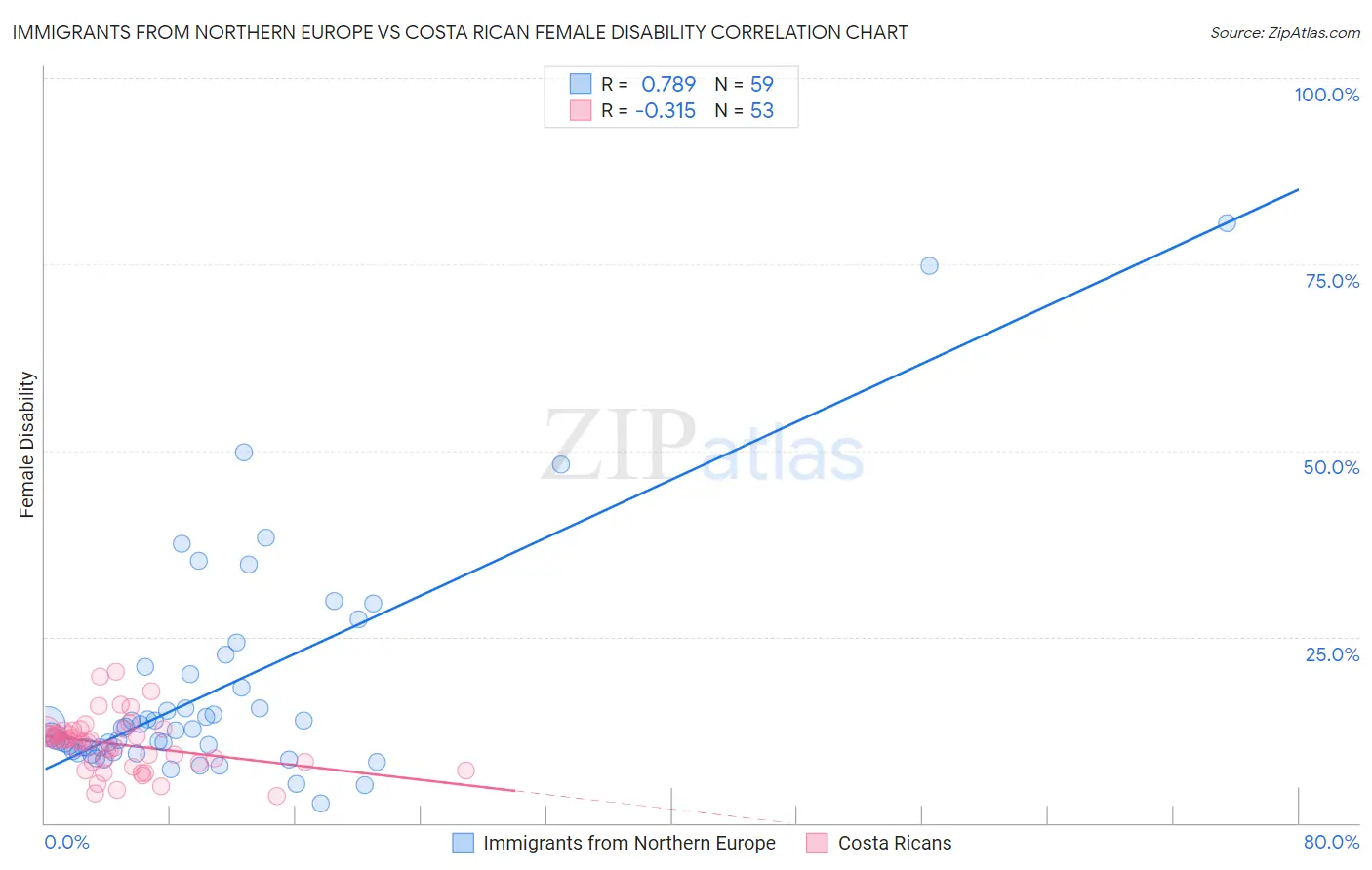Immigrants from Northern Europe vs Costa Rican Female Disability
COMPARE
Immigrants from Northern Europe
Costa Rican
Female Disability
Female Disability Comparison
Immigrants from Northern Europe
Costa Ricans
11.6%
FEMALE DISABILITY
99.4/ 100
METRIC RATING
95th/ 347
METRIC RANK
11.7%
FEMALE DISABILITY
98.1/ 100
METRIC RATING
111th/ 347
METRIC RANK
Immigrants from Northern Europe vs Costa Rican Female Disability Correlation Chart
The statistical analysis conducted on geographies consisting of 477,174,714 people shows a strong positive correlation between the proportion of Immigrants from Northern Europe and percentage of females with a disability in the United States with a correlation coefficient (R) of 0.789 and weighted average of 11.6%. Similarly, the statistical analysis conducted on geographies consisting of 253,556,053 people shows a mild negative correlation between the proportion of Costa Ricans and percentage of females with a disability in the United States with a correlation coefficient (R) of -0.315 and weighted average of 11.7%, a difference of 1.1%.

Female Disability Correlation Summary
| Measurement | Immigrants from Northern Europe | Costa Rican |
| Minimum | 2.6% | 3.6% |
| Maximum | 80.5% | 20.3% |
| Range | 77.9% | 16.7% |
| Mean | 17.9% | 10.6% |
| Median | 12.6% | 11.1% |
| Interquartile 25% (IQ1) | 9.7% | 8.1% |
| Interquartile 75% (IQ3) | 19.9% | 12.3% |
| Interquartile Range (IQR) | 10.2% | 4.2% |
| Standard Deviation (Sample) | 15.2% | 3.6% |
| Standard Deviation (Population) | 15.1% | 3.6% |
Demographics Similar to Immigrants from Northern Europe and Costa Ricans by Female Disability
In terms of female disability, the demographic groups most similar to Immigrants from Northern Europe are Immigrants from Brazil (11.6%, a difference of 0.070%), Immigrants from Sierra Leone (11.6%, a difference of 0.10%), Immigrants from Russia (11.7%, a difference of 0.46%), Korean (11.7%, a difference of 0.46%), and Uruguayan (11.7%, a difference of 0.61%). Similarly, the demographic groups most similar to Costa Ricans are Immigrants (11.7%, a difference of 0.020%), Soviet Union (11.7%, a difference of 0.020%), New Zealander (11.7%, a difference of 0.050%), Latvian (11.7%, a difference of 0.070%), and Immigrants from Greece (11.7%, a difference of 0.090%).
| Demographics | Rating | Rank | Female Disability |
| Immigrants | Sierra Leone | 99.4 /100 | #93 | Exceptional 11.6% |
| Immigrants | Brazil | 99.4 /100 | #94 | Exceptional 11.6% |
| Immigrants | Northern Europe | 99.4 /100 | #95 | Exceptional 11.6% |
| Immigrants | Russia | 99.0 /100 | #96 | Exceptional 11.7% |
| Koreans | 99.0 /100 | #97 | Exceptional 11.7% |
| Uruguayans | 98.8 /100 | #98 | Exceptional 11.7% |
| Immigrants | Philippines | 98.6 /100 | #99 | Exceptional 11.7% |
| Immigrants | Uruguay | 98.5 /100 | #100 | Exceptional 11.7% |
| Immigrants | Costa Rica | 98.4 /100 | #101 | Exceptional 11.7% |
| Immigrants | South Eastern Asia | 98.4 /100 | #102 | Exceptional 11.7% |
| Immigrants | Eastern Africa | 98.3 /100 | #103 | Exceptional 11.7% |
| Immigrants | Western Asia | 98.3 /100 | #104 | Exceptional 11.7% |
| Australians | 98.3 /100 | #105 | Exceptional 11.7% |
| Immigrants | Greece | 98.2 /100 | #106 | Exceptional 11.7% |
| Latvians | 98.2 /100 | #107 | Exceptional 11.7% |
| New Zealanders | 98.1 /100 | #108 | Exceptional 11.7% |
| Immigrants | Immigrants | 98.1 /100 | #109 | Exceptional 11.7% |
| Soviet Union | 98.1 /100 | #110 | Exceptional 11.7% |
| Costa Ricans | 98.1 /100 | #111 | Exceptional 11.7% |
| Immigrants | Bangladesh | 97.8 /100 | #112 | Exceptional 11.8% |
| Immigrants | Belarus | 97.8 /100 | #113 | Exceptional 11.8% |